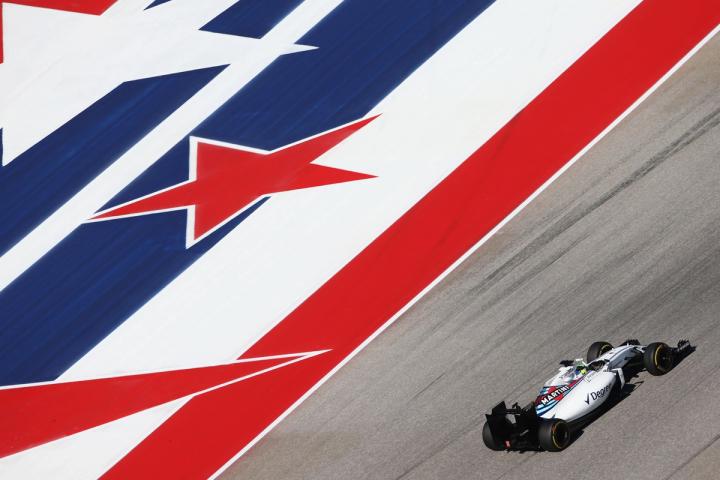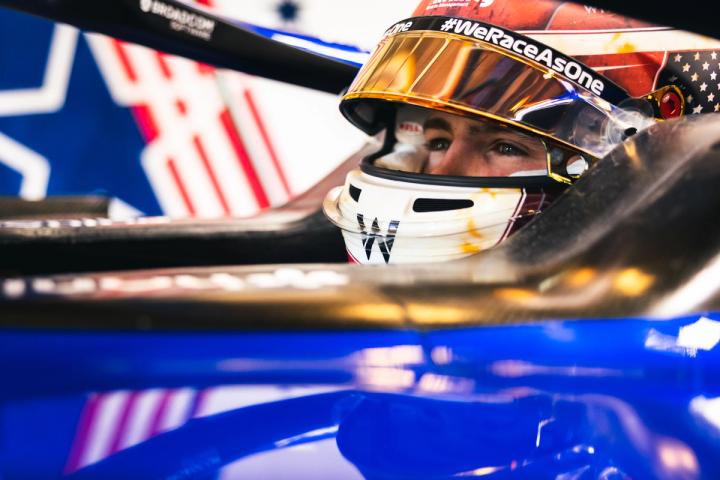Williams Racing are preparing to head back to Texas next week for the second of three Formula 1 races in the USA this season – the US Grand Prix.
With a visit to Miami already under our belts this season, plus a trip to Las Vegas in November, Formula 1 and the United States are enjoying something of a love affair.
The sport and country have a long history filled with many good moments, some bad ones and one that was downright ugly. Here’s everything you need to know about the history of F1 in the USA.
The Early History of F1 in the USA
Newer fans may be familiar with Formula 1’s races in America being at the hugely popular Circuit of the Americas in Austin, Texas. However, F1 has been racing in the U.S. before the F1 World Championship that we know even existed.
The 1908 ‘American Grand Prize’ took place in Savannah, Georgia, with the Frenchman Louis Wagner winning after 16 laps on a 40km-long public road track. Curiously, Wagner also won the first official British Grand Prix in 1926, but neither victory sits in the Formula One World Championship’s history books.
The USA’s first F1 World Championship event came in its inaugural 1950 season, though it wasn’t the United States Grand Prix but another familiar name. The 1950 Indianapolis 500 also doubled as Formula One’s third championship round, despite the odd situation of zero runners from the opening two Grands Prix at Silverstone and Monaco being present.
After heavy rain curtailed proceedings, Johnnie Parsons won the race – and that rain also saw the 1950 Indy 500 become the first F1 race to have a red flag. The American picked up the famous Borg-Warner trophy only to find the silversmiths had misspelt his name!
Despite most regular F1 drivers and teams not attending, the Indy 500 continued to be part of the F1 World Championship for 11 years before dropping off the F1 calendar after 1960. After all, an actual United States Grand Prix had appeared by then…
Formula 1, meet the United States Grand Prix
In 1959, Formula 1 held the first championship-recognised United States Grand Prix at Sebring, Florida. The race doubled up as the season finale, where one of Jack Brabham, Stirling Moss, or Tony Brooks would receive the championship trophy.
The legendary Bruce McLaren took his first F1 win, while Brabham’s P4 finish earned him the title. McLaren became the youngest F1 race winner in history at 22 years old, 3 months and 12 days on that Sunday in the USA. A record he kept until a certain Fernando Alonso won the 2003 Hungarian Grand Prix aged 22 years, 0 months and 26 days.
Although McLaren and Brabham enjoyed a successful day in Sebring, the event promoter did not, with the U.S. audience not taking to Formula One as he had hoped (if only he could see it now…). In 1960, Riverside, California, would host the race, but, as with Sebring, this would be the only United States Grand Prix the venue would host that made it into the F1 World Championship.
Win a VIP Vegas Experience with Williams Racing!
A once-in-a-lifetime prize is up for grabs – will you be our VIP guest when we race on The Las Vegas Strip?

From ’61 onwards, F1 found a long-term home in the USA, as Watkins Glen, New York, became the latest venue to welcome the sport. So at long last, The United States had a circuit Formula One visited every year – a pairing that lasted two decades until 1980, with frequent updates and tweaks.
The New York track’s last F1 race also doubled as the final round of Williams’ first championship-winning season. Alan Jones entered the Grand Prix as the new world champion and celebrated his first lap as champ by falling off the track at the first corner to end up amongst the backmarkers! Undeterred, though, Alan still took his Williams FW07B back to the front to be the final F1 winner at The Glen.

During its time in New York, Formula 1 established an American foothold and looked to grow more prominent in the motorsport-obsessed country where NASCAR, IndyCar, and Sports Car racing reigned. Watkins Glen, popular as it was, would not be enough.
The many names of F1 in the USA
With higher interest levels from the USA during the Watkins Glen days, F1 began to race at more American venues in the ’70s and ’80s. However, with the United States Grand Prix name already in use, there couldn’t be a second USGP. And so began an era of American Grand Prix names that have kept pub quiz hosts happy ever since.
Long Beach, California, became the location for the imaginatively-titled United States Grand Prix West from 1976 until 1983. The celebrated street track had hopes of being F1’s answer to Monaco in the USA. Unfortunately, although popular, it was expensive to run hence its demise after seven events.
Las Vegas joined the fun in 1981 with the Caesars Palace Grand Prix, and you’ll be shocked to hear the Grand Prix raced at the… Caesars Palace Hotel. Williams driver Alan Jones won the ’81 race, but it lives in infamy for being held in the car park – or parking lot, as the Vegas locals would say – of the hotel. It returned in 1982 for one more race, but Las Vegas soon became part of F1 history in the USA…for the time being.
That 1982 season was a boom for F1 in the USA as the Detroit Grand Prix had also begun. The year marked the first time any country had hosted three rounds of F1, something the U.S. will do again in 2023. Motor City, as it’s known, would hold the Detroit Grand Prix until 1988, including Keke Rosberg’s win for Williams Racing in 1985.
Keke and Williams also won the sometimes overlooked Dallas Grand Prix in 1984. The temporary Texas track only saw one Grand Prix and is perhaps most famous for being the site where Nigel Mansell collapsed while pushing his car to the finish line under 100 °F heat (that’s 37.7 °C if you don’t speak American).
The United States Grand Prix returned to continue F1’s stateside presence in 1989 with the Phoenix street circuit. However, the track didn’t stay on the calendar for long, exiting the sport after 1991. With Phoenix’s departure, F1 ceased to have a Grand Prix in the United States – whatever the name – for the first time since 1959.
The 2000’s: F1’s Amazing Fall…
Without Formula 1 racing in the USA through most of the 1990s, the Indianapolis Motor Speedway bosses became determined to be the circuit where the sport would mark its United States comeback. Finally, after years of campaigning, they got their wish, and Indianapolis would again be on the F1 calendar in 2000. However, this time it would run separately from the Indy 500, unlike in the 1950s.
The marriage of the world’s most-watched motorsports with America’s premier motorsport venue seemed perfect. With a weekend attendance of 250,000 for the first Grand Prix, F1 was back in the U.S. in a big way with seemingly nothing to stop it – apart from itself.
All the upward momentum changed with the 2005 United States Grand Prix. Labelled “a farce” by David Coulthard, and Formula 1’s “saddest day” (and other NSFW words) by Minardi Team Principal Paul Stoddart, the scenes on Sunday 19 June 2005 represent F1’s worst American moment by far, if not the entire history of the sport.
With the Indianapolis circuit resurfacing the banked Turn 13 with a more abrasive surface since F1’s 2004 visit, driver safety became a primary concern after tyre failures from supplier Michelin. Despite attempts by the teams to alter the race, there was no unanimous agreement or workable compromise that could guarantee drivers with Michelin tyres could drive without risk for over ten laps.
Just six cars lined up on the grid after the 14 Michelin runners withdrew from the Grand Prix after the formation lap amidst booing by attending fans. The incident ruined the sport’s reputation in the U.S. F1 left Indianapolis – and America – two years later.
Join the team
Sign up to unlock your very own Driver Card and be one of the first to know about all the latest Williams Racing news and announcements.

The 2010’s: …and Rise in the USA
How F1 was going to restore its American image was a hot topic of conversation. Finally, the answer came in 2010 when Austin was awarded a ten-year contract to host the U.S. Grand Prix from 2012. Unlike the many street circuits from the 1980s or racing in the shadow of NASCAR and IndyCar as F1 did in Watkins Glen and Indianapolis, Austin would construct a new racetrack with F1 in mind.
Texas wasn’t the only state with Grand Prix aspirations. New Jersey looked to host a second U.S. Grand Prix – the Grand Prix of America – with the world-famous Manhattan skyline in the background. The event even made it to the provisional calendar in 2013 but never materialised.
Despite the failures of Indianapolis seven years earlier, the brand-new Circuit of the Americas at Austin proved to be an overwhelming success in 2012. A capacity crowd turned up on Sunday, and drivers and fans alike praised the circuit’s layout, which took inspiration from classic European tracks.

Felipe Massa at the 2016 United States GP
The Austin event’s prestige grew as the weekend turned into a festival with pop music sensations Justin Timberlake, Bruno Mars, Britney Spears, and Taylor Swift all performing over the years.
F1’s 2017 takeover by U.S. media giant Liberty Media also gave the sport a further shot in the arm, and Formula One began looking at new ways to improve the show.
A glimpse of that future came in Liberty Media’s first race on home soil with Michael ‘Let’s get ready to rumble’ Buffer’s unforgettable driver introduction ahead of the race.
Show your support for Sarge…
To Miami and Vegas
Liberty Media did much more than bring in a sports announcer for a one-off appearance; they revolutionised Formula One in the digital world. A commitment to video production on social networks and F1TV brought high-quality content to the fingertips of anyone, and they sanctioned the hit Netflix documentary Drive to Survive.
While the rest of the world had some history with F1, Liberty recognised that new motorsports audiences, particularly the still relatively-untapped America, would benefit from a deeper understanding of F1’s intricacies. So how better to do that than with free short explainer videos on YouTube and a television show with more backstabbing and sass than The Real Housewives?!
The move worked, and F1 viewing figures have rocketed in the United States over recent years. Last year’s U.S. Grand Prix was the highest-attended Formula 1 race in history, with some 440,000 spectators passing through the gates of the Circuit of the Americas over the weekend.
With capacity crowds in Texas and viewing figures growing, it is now, more than ever, when F1 needs more American venues. Fortunately, it had two ready to go in the 2020s as Miami and Las Vegas enter the fray.
Excitement had reached a fever pitch for the maiden Miami Grand Prix with its new semi-permanent track around the Hard Rock Stadium, home to the Miami Dolphins NFL team.
Pre-sale tickets for the Miami Grand Prix sold out in under an hour, and all grandstand seats were gone just days after becoming available.
And if you thought the hype for Miami was big, well Formula 1’s return to sin city will take it to the next level.

Logan Sargeant made his Grand Prix weekend debut at the 2022 United States Grand Prix
The 2023 Las Vegas Grand Prix will see the world’s best battle it out down The Strip at night – along with the hugely popular Circuit of the Americas in Austin staying on the calendar, we’re going to see a lot more of the stars and stripes from here on out.
All of this means our very-own Logan Sargeant can lead the crowd when The Star-Spangled Banner proudly rings out at all three venues.
So at long last, in its 73-year history, it looks as though Formula 1 has conquered America.
The official Williams Racing app
Download our app for all the latest news, behind-the-scenes videos, our Pit Wall Predictions game and much more.


